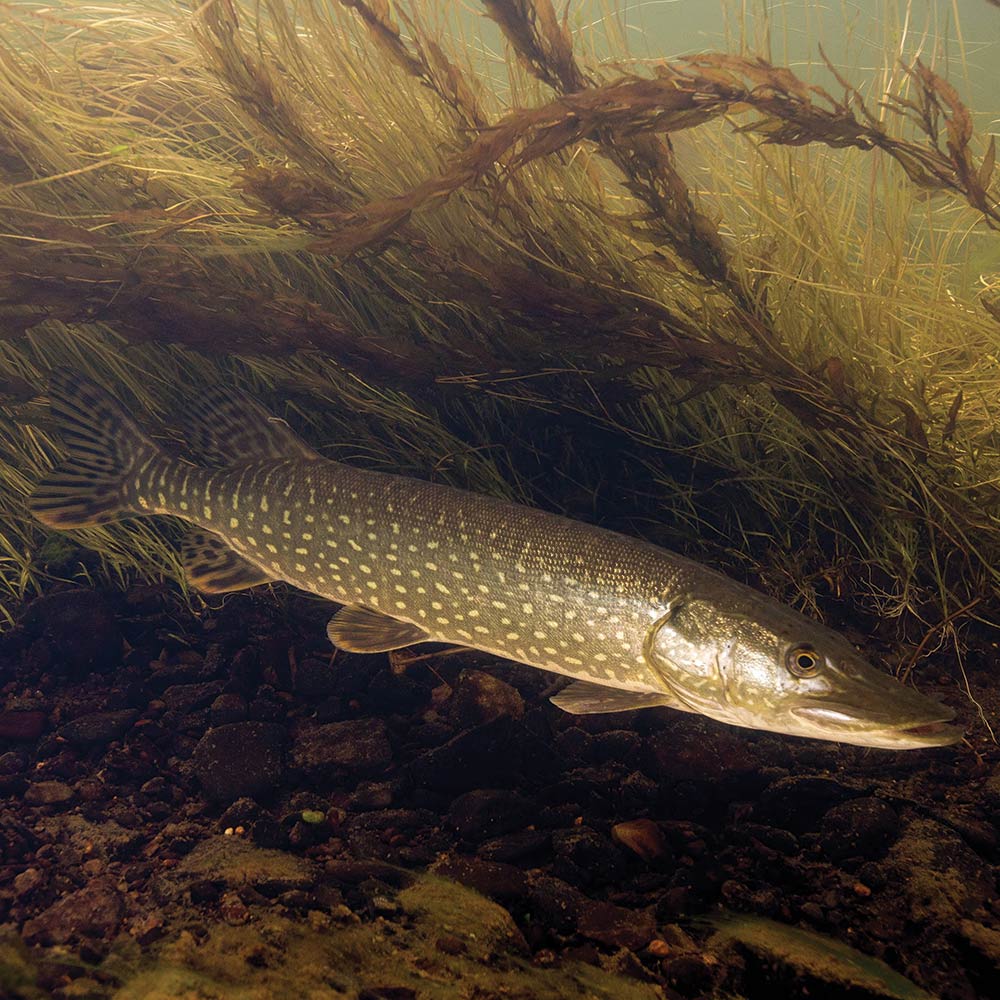Voracious Weed Prowler
The Great Outdoors | July 1, 2022

By Jackie Scharfenberg, Forest Naturalist, Wisconsin Department of Natural Resources
Wait for it… Wait for it… Then, lunge from the weeds for another tasty fish!
We adult northern pike (Esox lucius) dominate all other species in the aquatic food chain including muskellunges (muskies) even though they may be larger than us.
Hard to Find
You need to search carefully to find me as I secretively lurk alone amid the weeds. My light to dark olive green head, back, and upper sides camouflage perfectly with the weeds. You can identify me by my light colored, bean-shaped spots that run the length of my body in horizontal rows along with my pearly white belly and orange-yellow tiger striped rounded fins. Check out my duckbill shaped snout. Our hard-muscled, elongated, tube-shaped bodies are built for speed, allowing us to swim up to ten miles per hour. This makes us awesome ambush predators.
Hunting
Nothing escapes my fine set of sharp teeth set in my powerful jaw. Canine (conical, pointed) teeth ring my wide lower jaw while short, sharp brush-like teeth line the roof of my mouth and tongue. This spells instant death to any unwary prey.
Since we use sight to locate prey, we feed mostly during the day. We will eat any vertebrate that we can fit down our gullet from perch, suckers, and smaller northern pike to frogs, shrews, and shore birds. I have heard tale of some gluttonous northerns choking on prey that was too large for them to swallow.
Our Habitat
We prefer shallow lakes with a lot of weed cover. When the summer sun warms the water, we search out cool spots where streams enter the lake or springs. In deep lakes we head to the cooler water near the bottom. As you might have guessed, we love cool to cold water, so we remain quite active under the ice in winter.
Mating
Just as the ice breaks up in late March to early April, the spawning season begins. During the night, males swim to flooded areas or marshes with lots of grasses, sedges, and other emergent vegetation. A few days later the females join them. One to three males gather around a female in water up to 12 inches deep. They slap her with their tail fins. She then releases five to 60 eggs which the males fertilize with their milt. This takes three to ten seconds, and the process is repeated once a minute for an hour or more. The eggs adhere to the vegetation and hatch in 12-14 days. After ten days the fry begin to feed on zooplankton (microscopic animals). The larger fingerlings feed on small fish. We grow rapidly our first two years of life eating a lot, since it takes five to six pounds of food for every pound of weight we gain.
Only one percent of the eggs make it to adulthood. The eggs, fry, and fingerlings are prey for a whole menagerie of insects, fishes, aquatic mammals, and water birds. Those of us who reach adulthood, truly become the fearless, voracious top predators of our weedy lake habitats!



